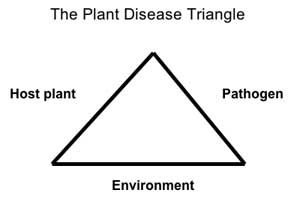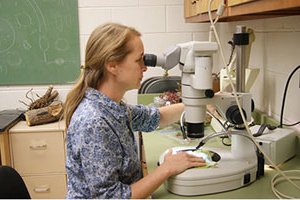Plant Diseases
A plant disease is any harmful condition that affects a plant's appearance or function. Common pathogens that cause diseases include: fungi, bacteria, and viruses. Some nematodes are plant disease agents. Temperature extremes or nutrient deficiencies are examples of disorders caused by non-infectious factors.
Pathogens are fungi, fungus-like water molds, bacteria, viruses, and nematodes that cause infectious diseases of ornamentals and turf. They are microscopic. Plant disease pathogens may be spread in many ways:
- wind;
- rain;
- animals;
- soil;
- nursery grafts;
- vegetative propagation;
- contaminated equipment and tools;
- infected seed stock;
- pollen;
- dust storms;
- irrigation water; and
- people.
Infection begins when the pathogen enters the plant. The disease process starts when it arrives at a part of a plant where infection can occur. If environmental conditions are favorable, the pathogen begins to develop. The plant is diseased when it responds.
Symptoms are the usually visible reactions of plants affected by these organisms. They may include leaf spots, chlorosis, cankers, galls, wilting, or root decay. Several types of pathogens can cause similar disease symptoms, so proper identification is very important.
Host-specific pathogens only infect certain hosts. If a host plant is not susceptible to infection, then the disease will not develop.
Also, environmental conditions must be right for infection. Most pathogens require wet conditions or high humidity so disease is usually much lower during very dry summers. On the other hand, rainy seasons usually produce more disease.
The disease triangle is a fundamental concept in plant pathology. Disease occurs only when all three sides of the triangle are present: a susceptible host, a pathogen (the agent that causes disease), and an environment favorable for disease to develop. Plant diseases are managed by manipulating the disease triangle: the plant, the pathogen, and/or the environment.

Plants respond to disease in 3 main ways:
- overdevelopment of tissue - galls, swellings, or leaf curls;
- underdevelopment of tissue - stunting, lack of chlorophyll, or incomplete development of organs; or
- tissue death - blight, leaf spot, wilting, and cankers.
Sometimes, adverse growing conditions or environmental factors produce symptoms similar to those of plant diseases. These abiotic problems (caused by non-living factors) need to be distinguished from plant diseases for proper management. For example, fungicide applications cannot correct frost injury, dog urine burn, nutrient deficiencies, drought, girdling roots, changes in grade, chemical injury, air pollution injury, and mechanical damage.
Knowing the disease-causing organisms allows selection of the proper chemical or cultural practice to control the problem. For example, a root problem identified as a root rot when it is actually a nematode infestation will not be cured by applying a fungicide; a nematicide is required.
Accurate identification and diagnosis is an art, as well as a science, and experience is essential. This section will acquaint you with the general symptoms of diseases. For more accurate disease diagnosis, consult your county Extension agent.
Diagnosis of Plant Diseases
 A correct diagnosis is the first step in disease management. You can recognize diseased plants by comparing them with healthy ones. To recognize a disease condition, you must know the plant's normal growth habits. When you are trying to identify the cause of a plant disease, you need to look for symptoms - the host plant's reaction to the disease agent, and signs - visible presence of the disease agent.
A correct diagnosis is the first step in disease management. You can recognize diseased plants by comparing them with healthy ones. To recognize a disease condition, you must know the plant's normal growth habits. When you are trying to identify the cause of a plant disease, you need to look for symptoms - the host plant's reaction to the disease agent, and signs - visible presence of the disease agent.
Many different plant diseases cause similar symptoms. Different pathogens and agents that are not pathogens can cause leaf spots, wilts, root galls, or stunted growth. For example, similar symptoms may be a result of mechanical injury, improperly applied fertilizers and pesticides, or frost. Often, the only way to pinpoint the cause is to find the observable signs that the particular disease agent is present -- such as fungal spores and mycelium or bacterial ooze.
[return]

